Wahoo has announced their first cycling radar, aptly called TRACKR Radar. This new radar does pretty much all the usual cycling radar bits, and integrates with everyone else, and costs about the same as everyone else. It has has a handful of new features though, and better battery life – which may give it the edge. Plus, it’s got USB-C.
I’ve been riding with it for the past week or so, putting it through its paces. So I’ve got a pretty good feel on how it handles, and how it compares, since all of my rides have had a Garmin radar concurrently to validate detection range/accuracy. The Garmin RTL-515 is widely considered the gold standard in cycling radar, and thus this needs to match that.
Yet, this isn’t an in-depth review. That won’t come till next month or so, once Wahoo hopefully starts selling it (more on that later). As such, consider this the first look/hands-on post as titled.
With that, let’s dive into it.
The Specs:
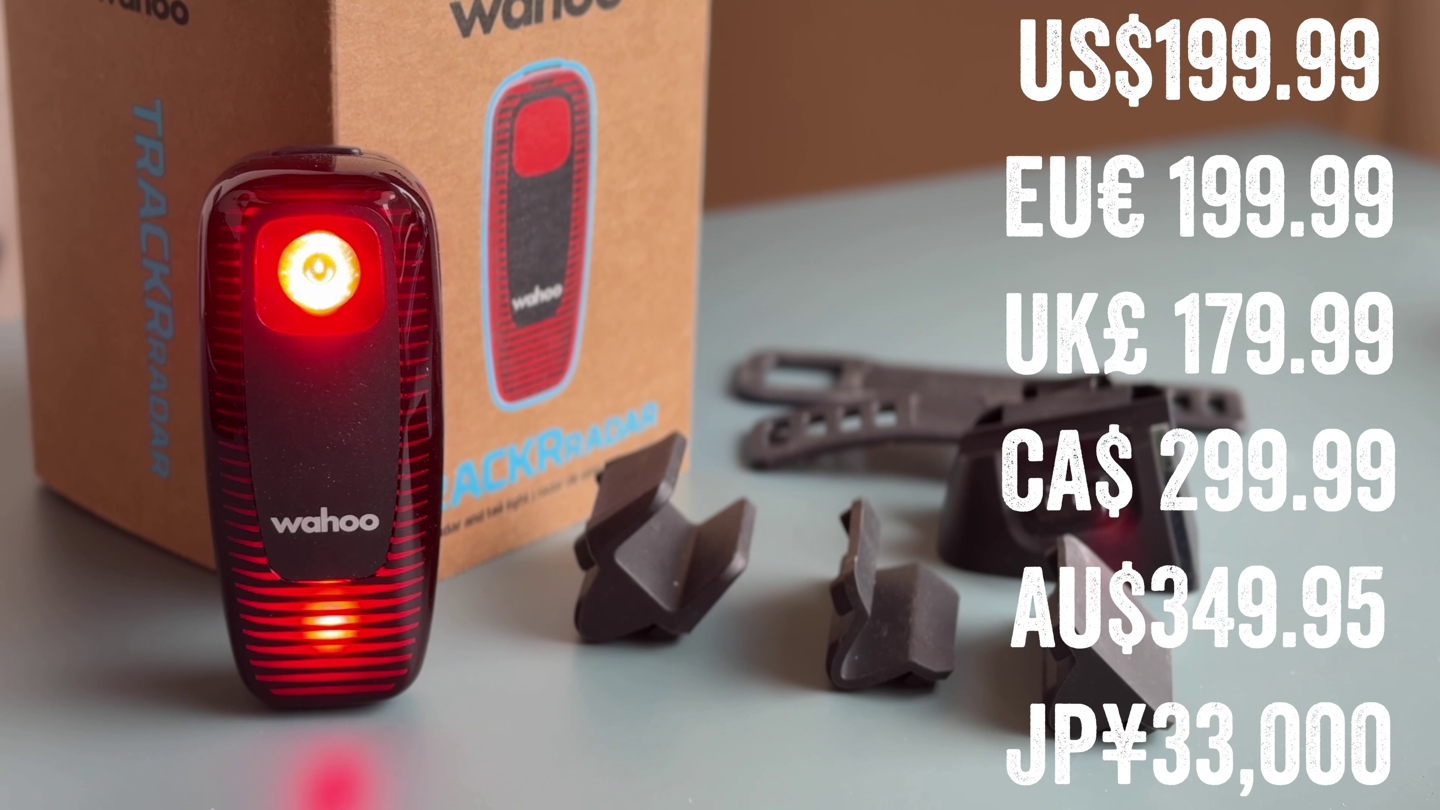
Ok, so getting into things, the Wahoo radar is pretty similar to others on the market. Both in terms of specs and features, though, it does have a few unique features. First, the standard ones:
– ANT+ Radar support: This is of course the main radar protocol that every radar and bike computer companies leverages, and Wahoo uses it here as well.
– ANT+ Smart Light Control: This means it acts as a light network on cycling computers and watches, according to the standards everyone uses. Good to see.
– Quick Alert: This will automatically trigger a flash pattern when a car approaches. This is standard for all radars out there.
– Configuration & Firmware Updates via Wahoo App: This one is pretty straight forward, however, do note that it does *NOT* have a radar overlay option within the app. Meaning, you can’t use the smartphone app to see radar alerts for cars behind you, as you can with competitor devices. You must have a bike GPS or compatible watch.
Now, there are a few unique bits here:
– Brake Light: When you start braking, the Wahoo Radar increases its brightness automatically. This is leveraging accelerometers and other sensors to do so.
– Dual LED’s: Wahoo is using multiple LED’s in the product, to increase brightness. You’ve got one main LED in the upper-middle, and then a secondary set around the outside edge. While Garmin and others have a smaller edge/side light, this is definitely more pronounced from the side.
– Battery Extender Mode: When there’s no cars behind you, after a predetermined time (you configure this), it’ll automatically reduce the brightness to save battery.
– Mode Memory: This will remember your last setting the next time you turn it on. Practically speaking, this feature doesn’t matter unless you don’t have a bike computer. Otherwise, every bike computer is automatically remembering and configuring those settings for you.
When it comes to some weight/spec details:
– Weight: 99g/3.5oz
– Size: 90mm/3.54” (W) x 82mm/3.22″ (H) x 42mm/1.65″ (D)
– IPX7 water resistance, so 1 meter deep for 30 mins
– Radar Field of View: 35*
– Warranty: 1 year (2 years in EU)
Oh, and yes, very much USB-C:
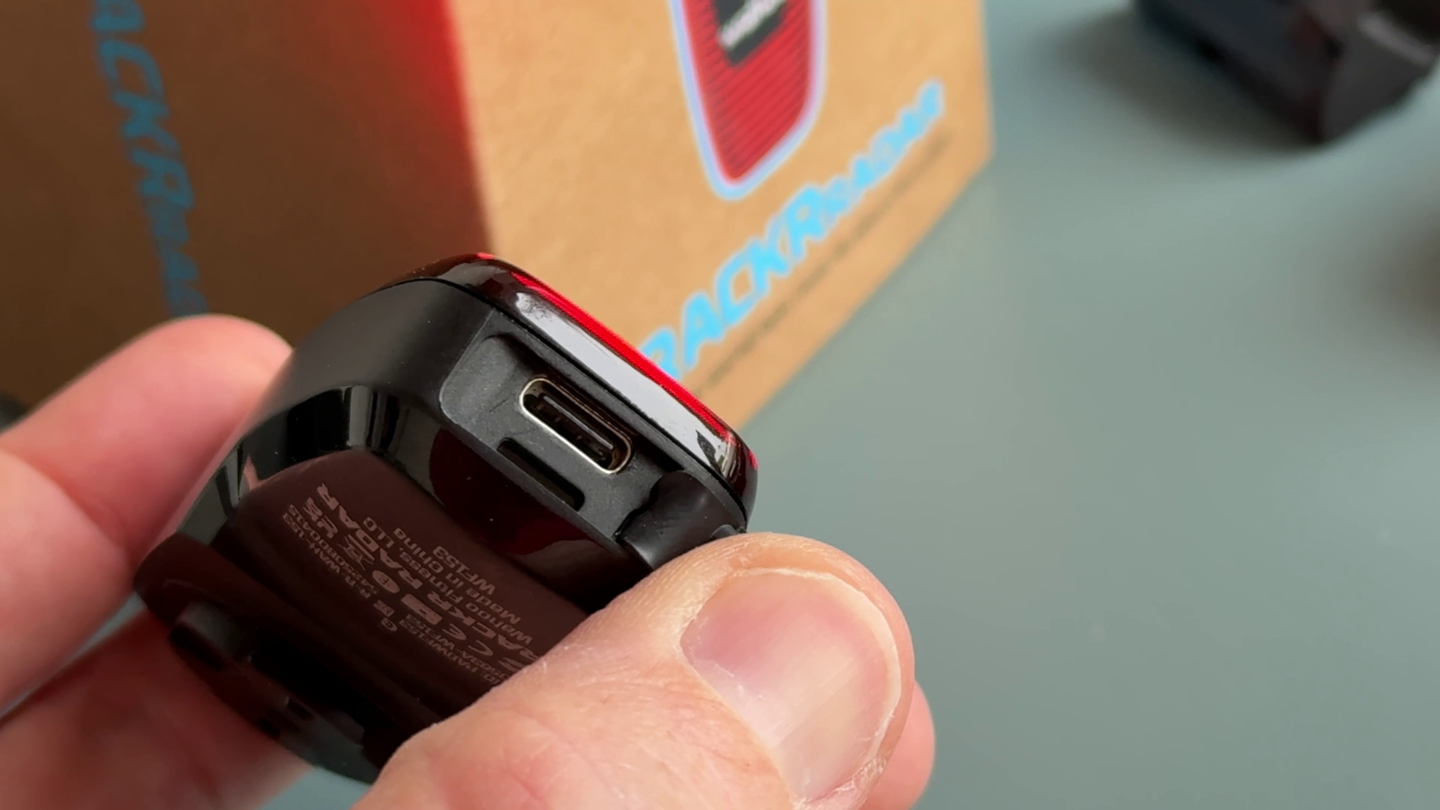
Finally, here’s the official battery life chart:

For comparative context, if looking at the Garmin Varia RTL-515, here’s those specs. In short, Wahoo easily beats Garmin here in almost every category:

Said differently, aside from daylight flash, which is basically a wash, Wahoo’s battery claims are roughly double that of Garmin.
The Mount (and Boxed Bits):
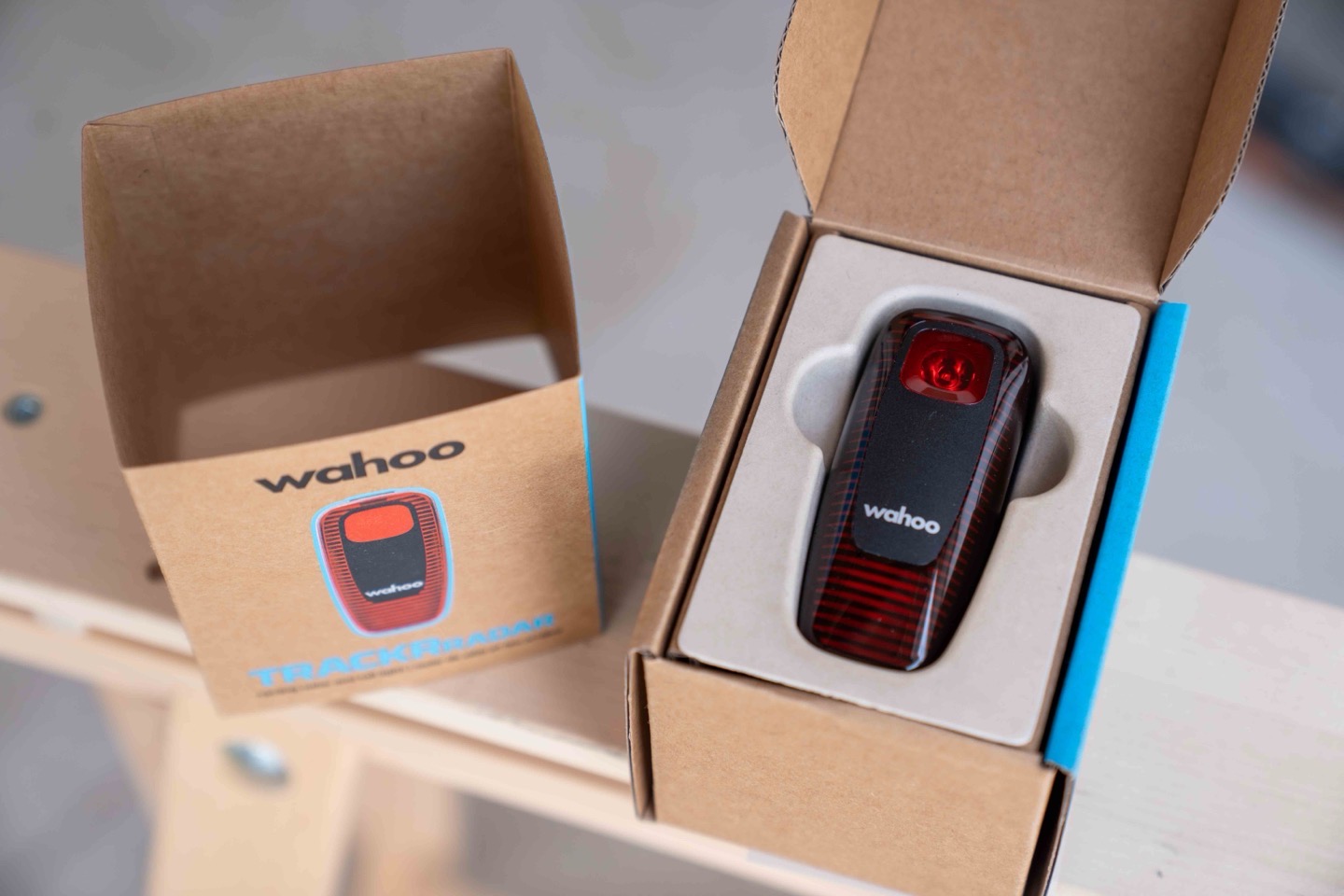
Now first up, here’s what’s in the box:
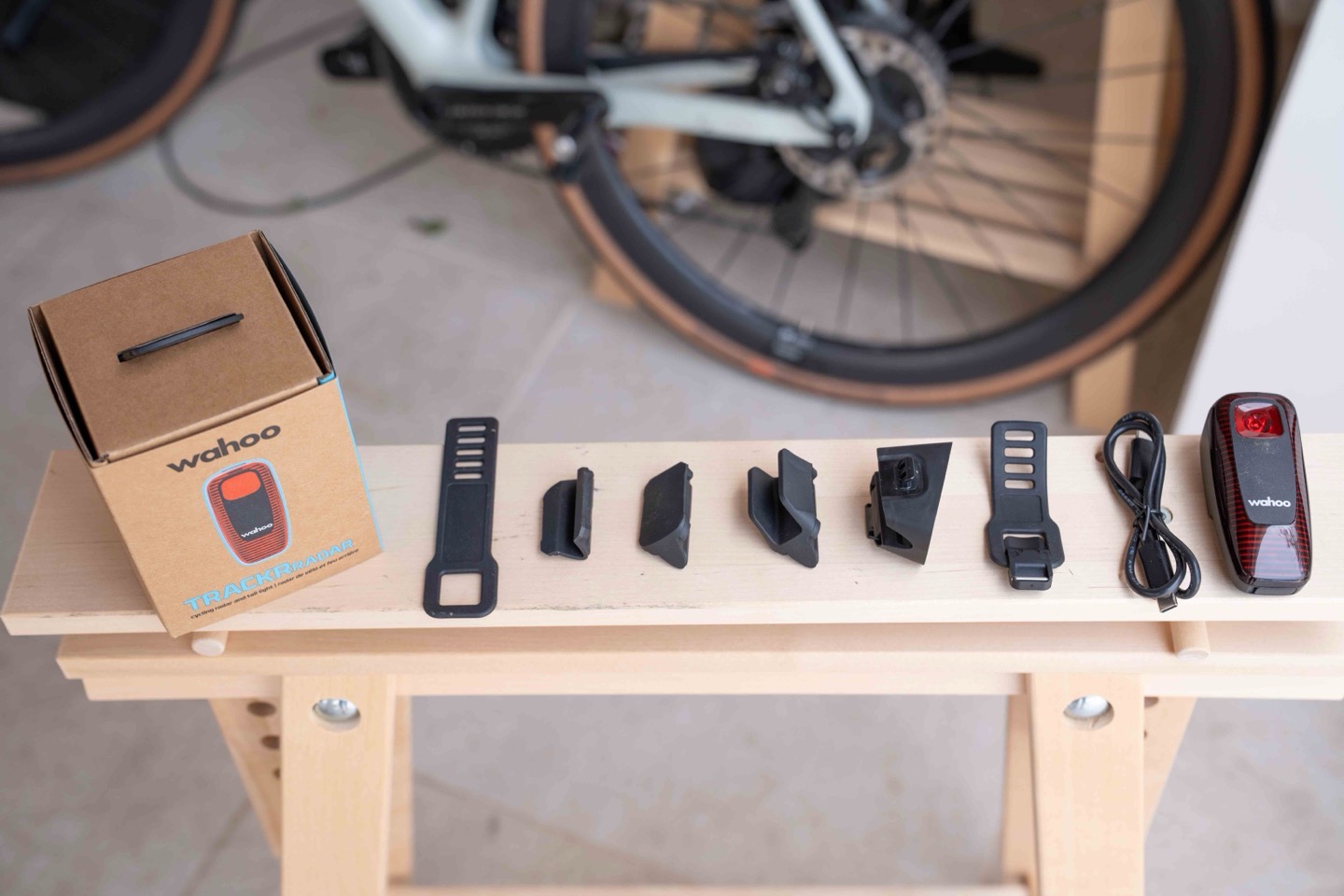
There’s three mount adapters in there: D-Shape, Flat, and supposed Round/Aero. I say supposed, because it’s basically just an aero mount that you can squish into being a round-post mount. And yes, it does technically work. I’ll need a month though to decide if it works well. Stay tuned.
Besides that, there’s two different straps (long and regular), as well as a USB-C charging cable, and some paper stuff.
Now, if there’s one thing that annoys me about the Wahoo RADAR, it’s the mount. In fact, it’s probably the only thing that annoys me about it. Specifically, Wahoo designed the mount tabs to be about 1mm bigger than what everyone else uses, thus, it won’t fit in other standard mounts. And that sets aside just how much extra bulk this mount design has.
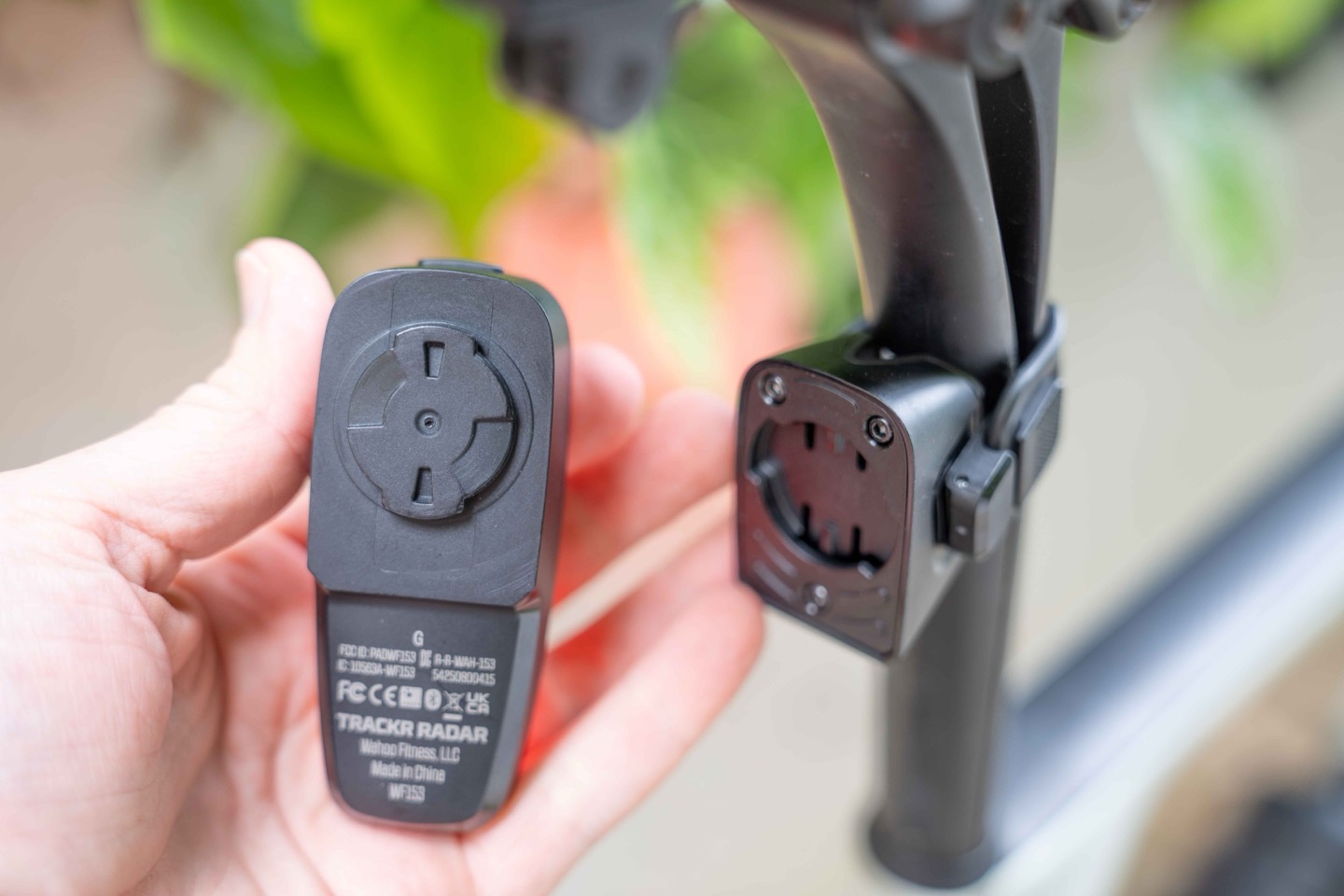
But when it comes to the non-compatibility, it means it won’t work with the gazillions of 3rd party mounts out there. Those mount work just fine with Garmin, Bryton, Magene, and other radars. Trek is the exception…well, and now Wahoo. It doesn’t fit the KOM cycling mount I have, or my wife’s triathlon bike saddle rail mount:
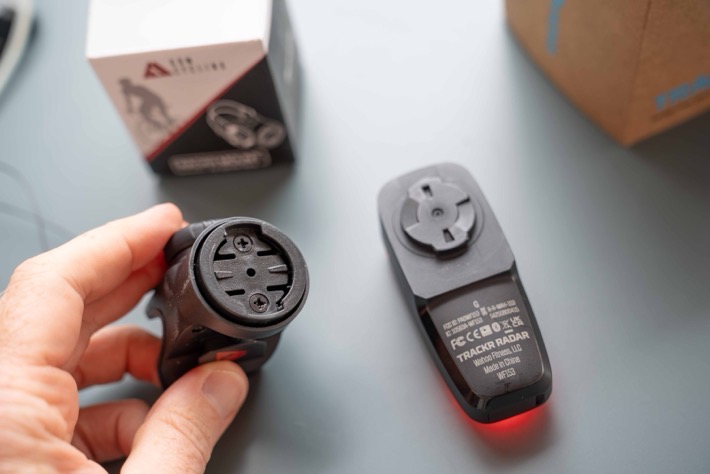
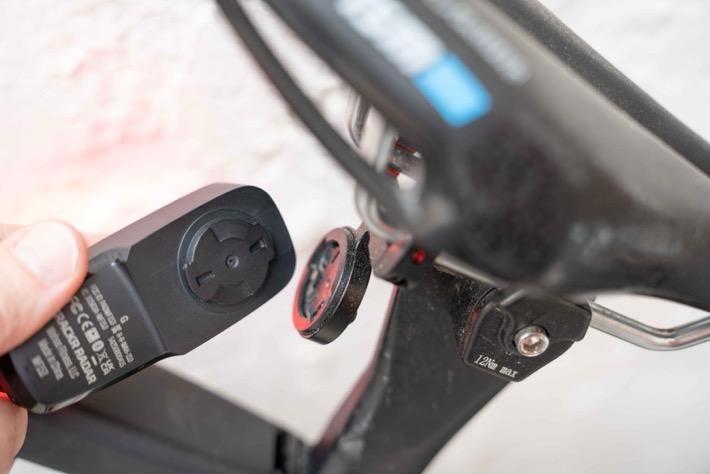
And look, I get that Wahoo has their ‘own’ bike GPS mount (which is just a Garmin quarter-turn mount rotated 90* and the tabs thickened 1mm to make it non-compatible and avoid what they thought a decade ago might be legal issues from Garmin). But given there was never a Wahoo radar before, there was zero reason to make it unique/non-compatible. Absolutely none. Especially now when it’s clear Garmin (over the course of 15 years) hasn’t gone after any other company for using that mount design in any bike computers, radars, lights, or anything else. Sigh.
Ultimately, this is only going to hurt Wahoo. It’ll lessen the chance people convert over, because many people have bought saddle rail mounts for their Varia radars, and with no saddle mount option available yet from Wahoo or partners (save a single KOM saddle bag for Wahoo), people are less likely to buy both a new radar and a new custom mount.
Some Initial Riding Thoughts:
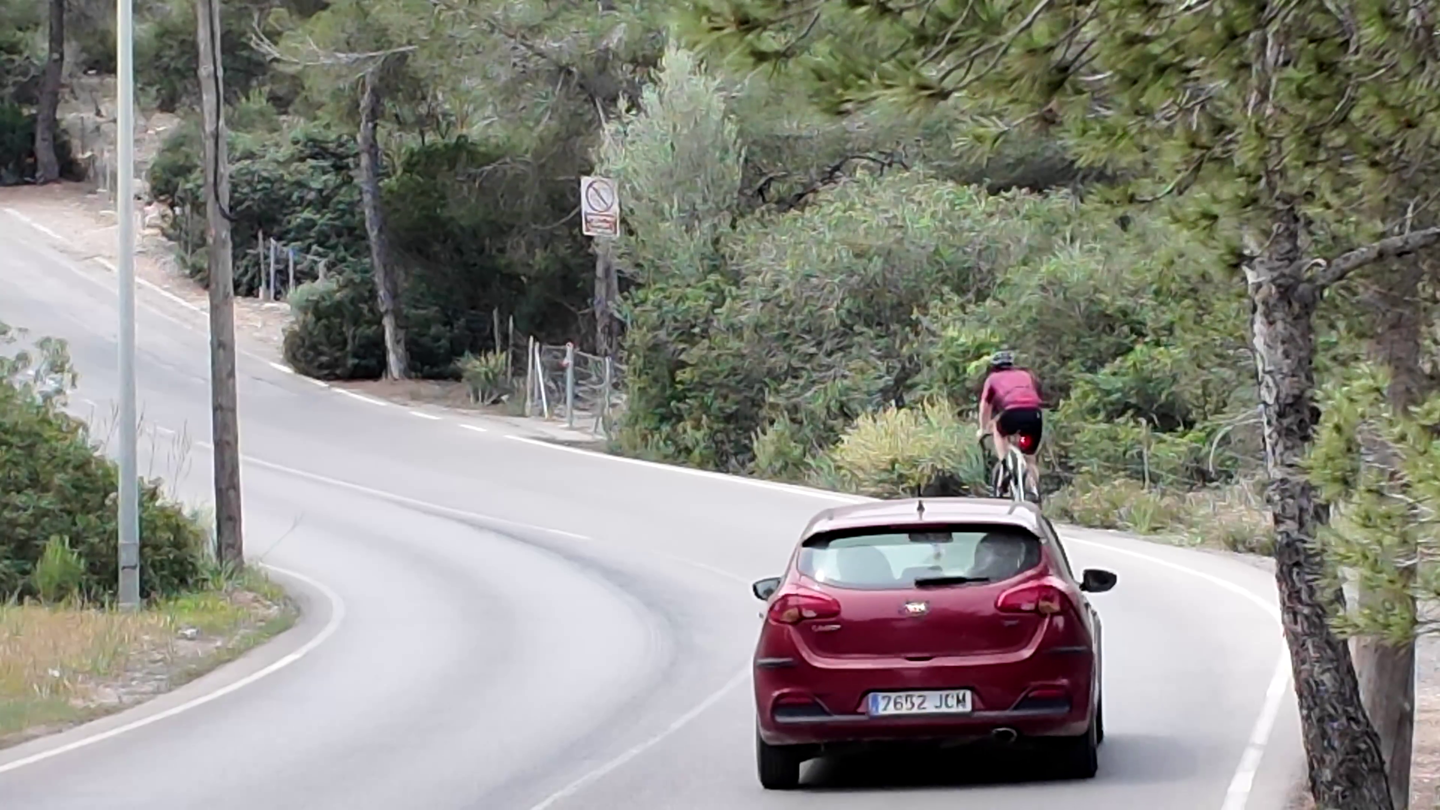
In many ways, a radar works best when you kinda forget about it, and it becomes an extension your bike. Living in the Netherlands, I frankly rarely bothered riding with a radar, because so much of the bike infrastructure was separated, I was on mostly desolate roads, or drivers were just really considerate. However, upon moving to Spain last year, it’s back in the ‘must have’ category. Drivers are largely good, but the road infrastructure isn’t the same for cyclists.
The roads I ride are sometimes long and narrow, and other times twisty mountain passes. Both are great scenarios for radar, especially on faster descents where the wind noise will cover up an overtaking/approaching car.
(Preemptive reminder again this software isn’t final, and may change in the coming weeks, see my final review eventually.)
Over the last week I’ve been riding with both the Wahoo and Garmin radars concurrently, paired to their respective bike computers. In probably 90-95% of the cases, the two radars triggered identically and within half a second of each other. In about 5-10% of the cases, the Garmin would trigger first by about 1-3 seconds. On paper, the Wahoo has a slightly longer detection range (150m vs the Garmin’s 140m), but as we learned with the Trek radar last year, paper detection range doesn’t mean anything (the Trek consistently triggered after Garmin).
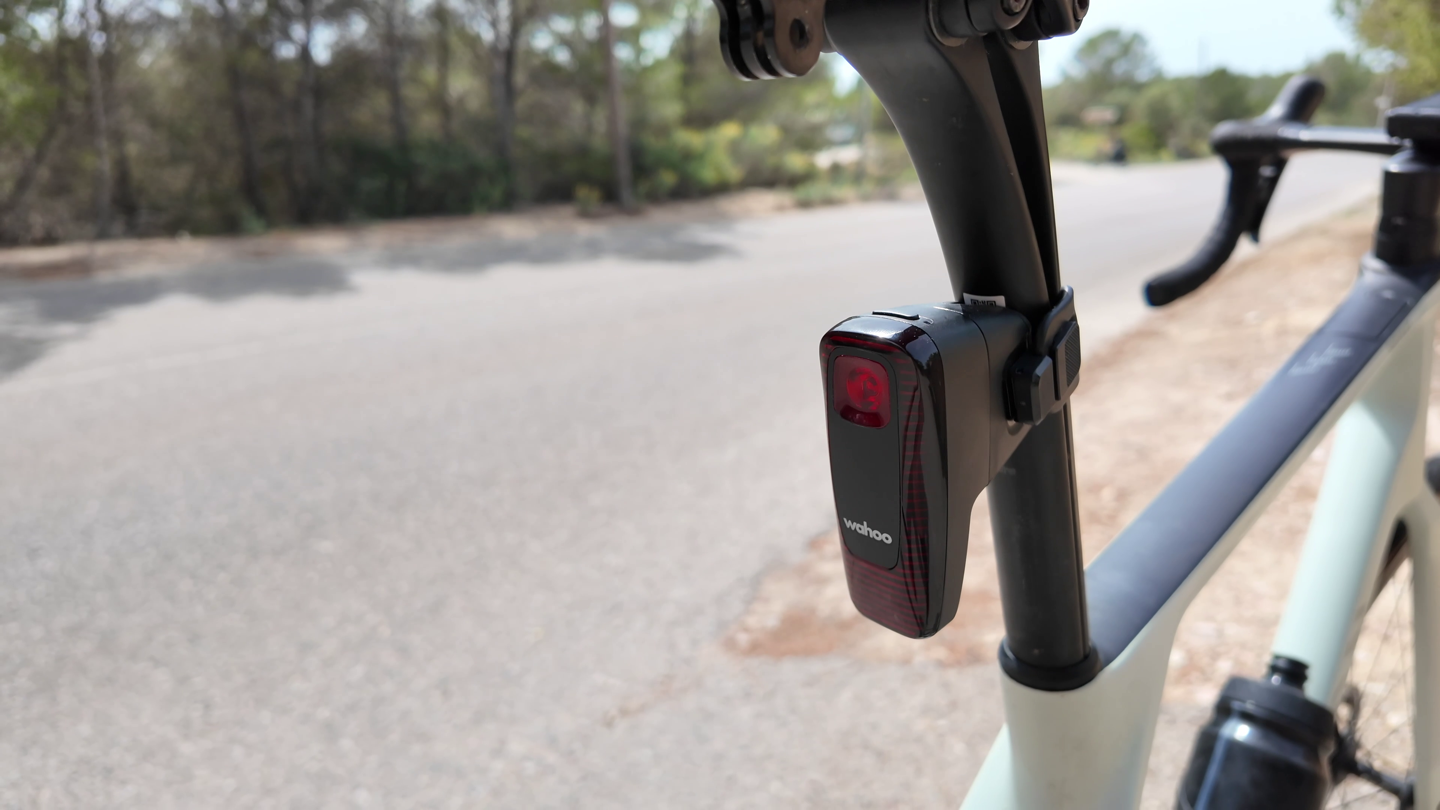
At first it was a bit tricky to figure out why Wahoo was likely triggering a little bit later, but riding on a bike path adjacent to a highway started to illuminate things. Specifically, the Wahoo wasn’t quite picking up as many highway vehicles as Garmin. At first glance, that’s not a bad concept – after all, short of a Fast and the Furious style Hollywood-esque action fail, these 120KPH vehicles weren’t coming anywhere near me.
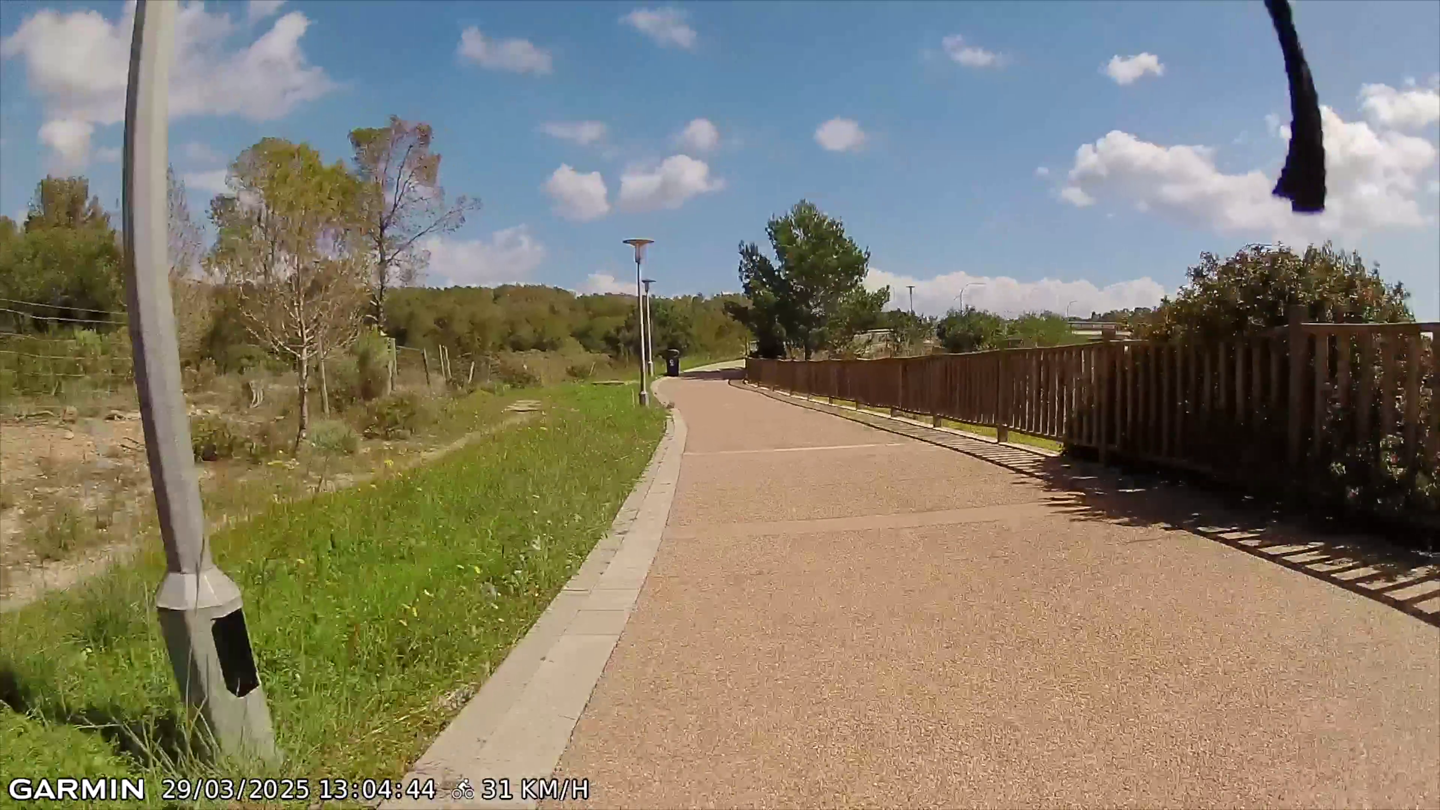
Yet at the same time, there are plenty of wider roads 3-lane each-way stroad’s in other areas that you would want to know about those offset vehicles.
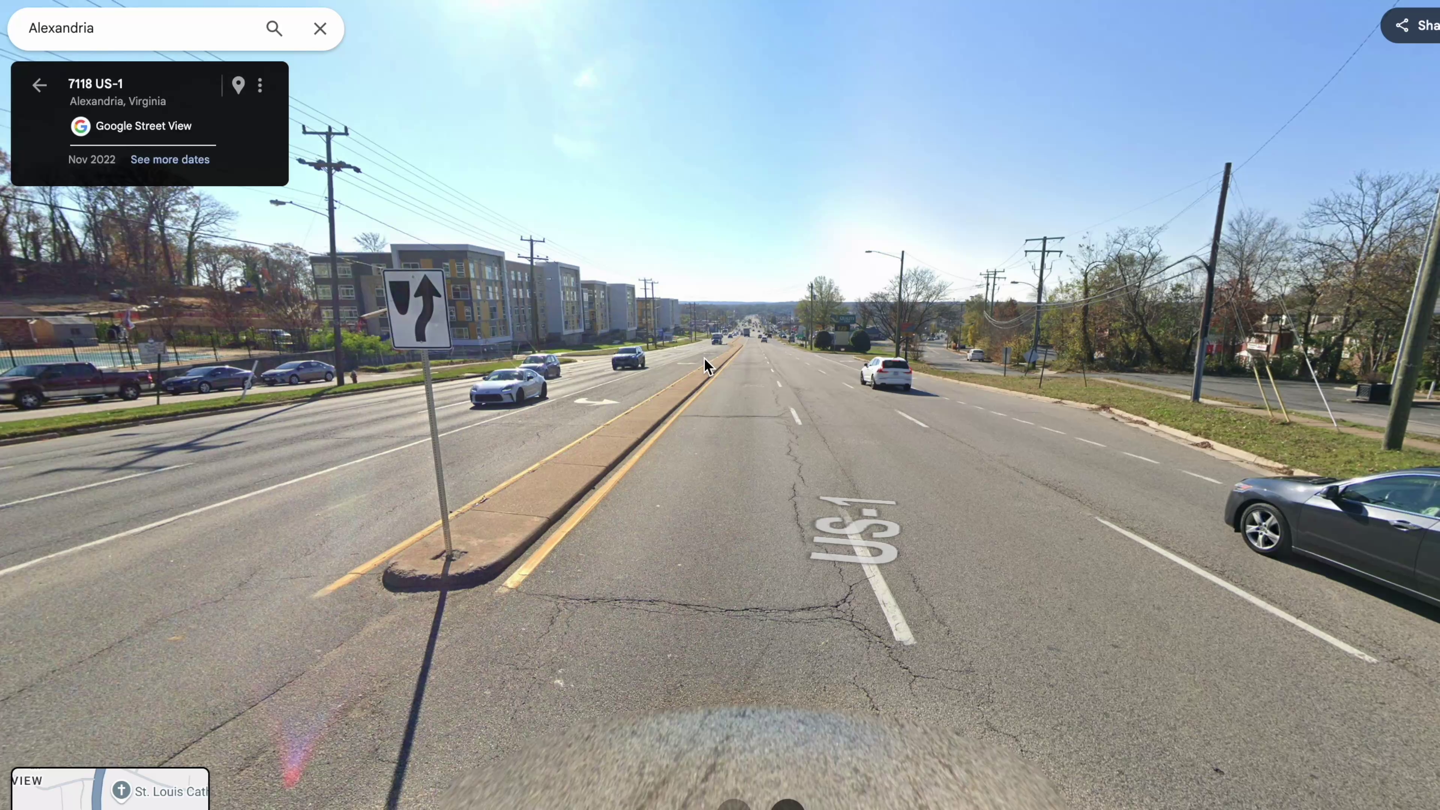
A bit of digging with both Wahoo and Garmin started to illuminate the likely reason: Wahoo’s radar FOV is 35*, whereas Garmin’s is 40*. Of course, that’s only part of the picture. The other piece is the differences in underlying radar tech range and radar type, a factor we’ve seen play out in offerings from numerous other players in the market.
The second area this seems to play out in, is some twisty mountain roads, where in just the right amount of cases, the car coming around a corner isn’t seen as quickly as the Garmin. Did this extra second or two matter in any of my cases? Nope, not yet. But that’s the rest of my testing period.
Moving onto some of the other features, these actually mattered more for cars, than for me directly. Meaning, there was no tangible benefit on my bike computer, but there was a benefit to drivers seeing me. This includes the brake-light action triggered by the accelerometer internally, as well as the longer-battery life by lowering the brightness when there was no cars around.
Beyond that though, basically everything worked as expected. I didn’t see any false positives yet in my rides (note that other cyclists are not false positives, those are very much correct detections).
Though if I’ve learned anything from radars, it’s not really a matter of if you’ll see false positives, but rather, when/how you’ll see them. Ultimately, radar bounces off objects in quirky ways. Most of my riding has been well out of the city in mountains/forests, whereas most false positives I see tend to be in city environments where things bounce oddly off of metal surfaces. Again, more in my full review.
Wrap-Up:
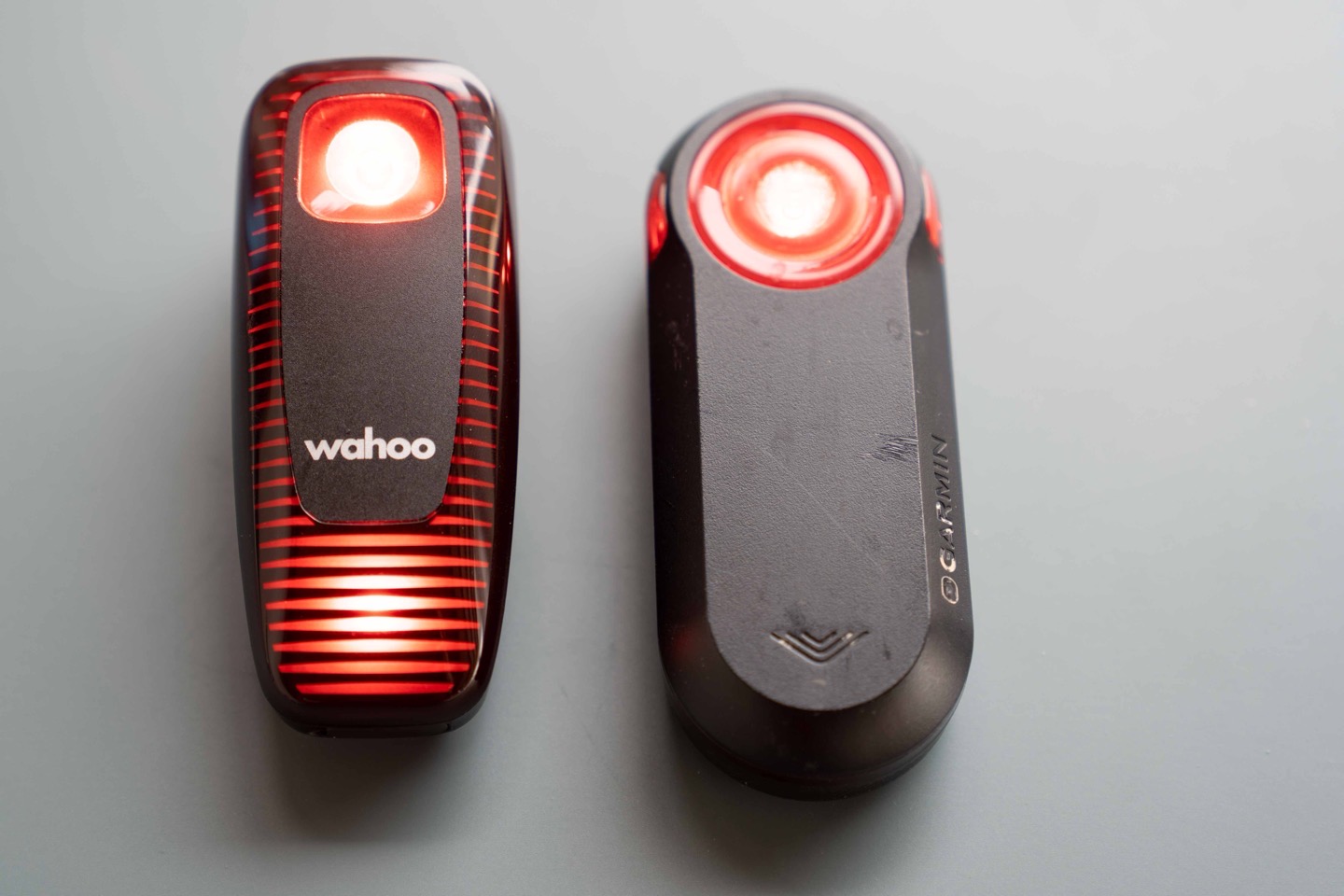
Once Wahoo releases the TRACKR RADAR, I’ll do a proper review after what’ll likely be at least a month or more of usage. Until then, this will act as that placeholder. However, short of it somehow crapping itself in the next month or so, it’ll probably be the radar I switch to going forward: Almost entirely because of USB-C.
Over the winter, my wife stole my Garmin Varia RTL-515. Which is fine, it has micro-USB, and is literally the only micro-USB device left in our household. So instead I used the Trek one instead. But it’s simply not as good as the Garmin radar in terms of detection range (especially notable when the two of us are riding together, and her radar alerts before mine every single time). But you know what the Trek radar had? USB-C.
Likewise, you know what the Wahoo RADAR has? USB-C.
And I know that’ll seem silly, but me and everyone else that’s been asking Garmin for many years to switch to USB is kinda over it. We’re buying USB-C radars from other companies, even if they’re not quite as good. But in Wahoo’s case, thus far in my early testing, it seems pretty darn close to be basically negligible. Plus, it’s got some other handy features in there (I’m interested in toying with the battery gains on some of those modes).
Now, I think Wahoo’s mount is frustratingly stupid. Straight-up, totally annoying. The thing is wildly over-engineered, doesn’t use what is effectively the defacto standard used by all other radars except Trek (Garmin, Bryton, Magene, etc… all use it). Which ultimately costs Wahoo owners more money to go and re-buy saddle and other mounts they already have.
In any event, setting aside the mount annoyances, it’s a great little radar that I’m looking forward to putting those battery claims to the test over the next month or so.
With that – thanks for reading!


0 Commentaires